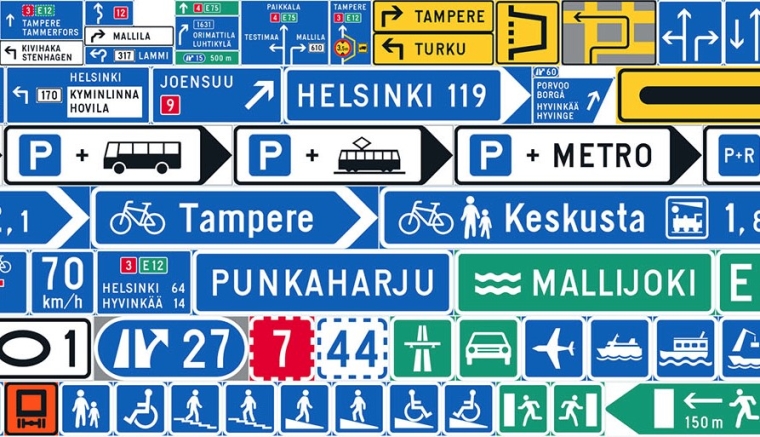
By Brendon Harre*
The Right to the City is a concept and slogan that emphasises the idea that urban spaces should be inclusive, democratic, and accessible to all residents. The idea was first articulated by French philosopher Henri Lefebvre in his 1968 book Le Droit à la Ville.
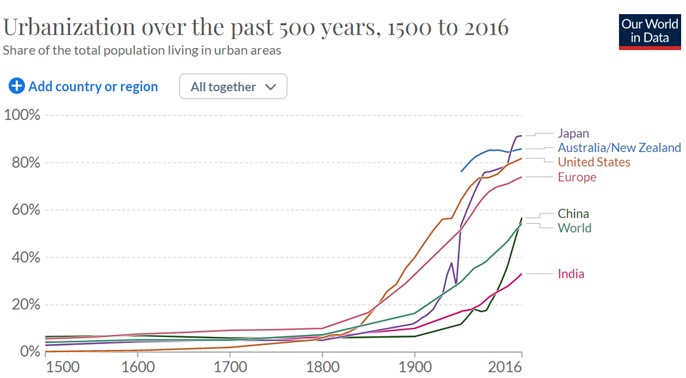
New Zealand is having one of its periodic episodes of anti-apartment NIMBYs and anti-sprawling planners talking past each other. Generation Rent are likely to be collateral damage in this clash. Is there a better way? Yes, learn from great cities.
When I wrote my last paper - New Zealand's Addiction to Land Speculation is its Forever Weakness - I stated it was possible there could be a backlash against pro-housing land-use reforms. To a degree that has happened, with a National party MP celebrating successfully lobbying to stop houses being built in his city electorate by undermining a bipartisan political agreement between National and Labour that would have enabled over 100,000 additional houses to be built in New Zealand’s major (tier 1) cities.
This is unfortunate because academic research has found quantitative evidence that the earlier Auckland Unitary Plan up-zoning has protected Auckland families from significantly higher rents, so the loss of planning certainty around up-zoning is a setback for addressing the housing component of the cost-of-living crisis.
The National party is clearly divided on this issue as its housing spokesperson Chris Bishop in recent interviews remains supportive of pro-housing land-use reforms (Q+A and Bernard Hickey’s podcast interview titled - How big does Chris Bishop want us to be?).

In other parts of New Zealand local homeowners have also successfully lobbied to exclude intensive housing for low-income earners being built in their area.
I could go into the details of these and other similar anti-house building events, but they have been well covered by the media and quite frankly they are a bit depressing. Instead of looking at the ‘bad’ I think it is helpful to look at what ‘good’ could be like.
What do great cities look like? What lessons can we learn? In what context are they being built?
All around the world for several centuries people have been moving from low density rural environments to higher density urban areas. This is not a result of a top-down policy prescription - it is the cumulative result of individual choice. Cities have a concentration of networks that rural areas lack – it is probably this factor which people are responding to.
Cities have numerous different types of networks.
Some physical – like the systems that provide residents with fresh water, remove sewer water, manage flood waters, provide public transport and roads.
Some social – like business networking meetings, hobby groups, sporting competitions, church groups, family and friend support networks.
There are networks that share knowledge - both formally, with institutions such as schools and universities, and informally, such as the café society of renaissance Europe.
Cities have large networks that better match labour skills to speciality tasks, give better recreational opportunities, and provide a greater variety of shopping choice. Some options like dating apps are not commonly thought of as networks yet have a strong location-based network effect.
Most of these networks are beneficial to cities (exceptions, such as the easier spread of communicable diseases or city destroying fires have mostly been mitigated away).
The benefits of networks can sometimes be measured quantitatively. Economists have calculated that cities typically get more productive as they grow in population size, and workers get more productive the more jobs they can access in a reasonable commuting time. Beneficial city network effects are called agglomeration by economists.
I would contend that cities have a ‘pull’ factor that is driving the growth of fewer, larger cities rather than there being a ‘push’ factor away from rural living which would result in the growth of many more, smaller rurally located townships.
The major constraint preventing city networks from becoming ever more concentrated – for stopping the theoretical possibility of there being one mega-city – is the need for the city to be located in a physical space. In other words, real-estate and travel speed are the major constraints that counteract the attractive agglomeration benefits of cities.
Historically the distance across an urban area was about one hours walk. This is because a rule of thumb that has been found to be true across different geographies, different travel modes, different cultures and historical time periods is people give themselves on average one hour for their daily travel budget – and very few people travel more than two hours a day.
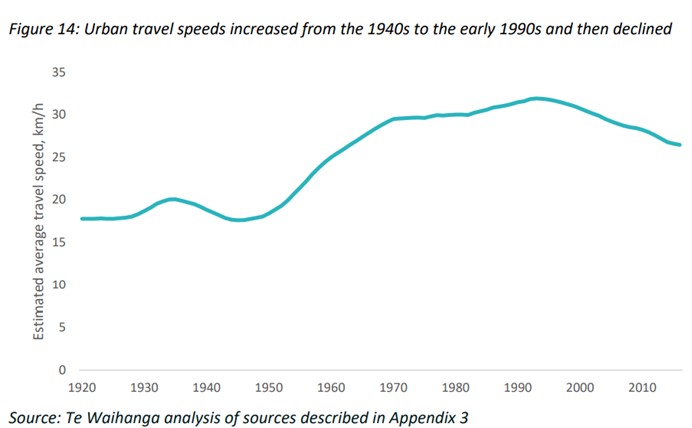
Auckland experienced congestion on its road network from the early 1990s.
The Infrastructure Commission made the following comment about their above graph.
“Rising travel speeds between the 1930s and 1970s facilitated housing supply by increasing the area where new homes could be built. Auckland’s built-up area expanded rapidly during this period. When growth in travel speeds slowed in the 1970s and then began to reverse in the 1990s, urban expansion also slowed down as it became harder to build at the edge of the city. It will be difficult to reverse the decline in travel speeds through investment, as new road capacity tends to ‘induce’ additional driving, resulting in few sustained benefits for travel speed. A potential approach would be to use a combination of congestion pricing, to mitigate severe congestion and widespread, low-cost deployment of new transport options to lift mobility.” Source - The decline of housing supply in New Zealand: Why it happened and how to reverse it – March 2022
When cities exceed the development capacity of its real estate, when demand for city life exceeds supply, then privately owned land and/or the publicly owned right-of-way corridors come under pressure. This results in either rapidly escalating prices for private property and/or increasing congestion of public spaces – traffic jams on roads etc.
In the past there have been some quite extreme mechanisms to manage excessive demand for street space.
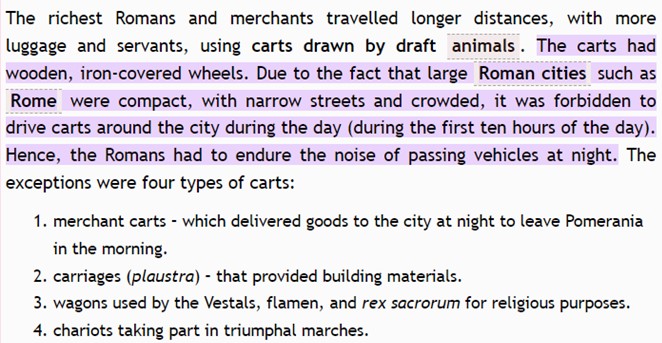
Mechanisms are needed that ensures the development capacity of a city’s real estate is such that it can respond to demand. This includes the demand of all newcomers – not just the wealthy like this link to an article on luxury condos clearly explains.
Given the vast majority of people – over 80% of people worldwide - are either currently living in urban environments or in the coming generations will move to urban areas it is important that these mechanisms genuinely do provide enough developmental capacity*.
Great cities have a greater variety and greater quality of beneficial networks. Not only that, great cities have inclusive networks. Newcomers and the next generation are able to find a place in city networks that provides them with the best opportunities.
What mechanisms have great cities used? Primarily great cities are the result of very long-term spatial planning tools (mostly 50 years plus) that provide ‘up and out’ developmental opportunities that has allowed supply to keep ahead of demand. Crucially, in addition to providing private property development capacity these spatial planning policies designated high quality public right-of-way corridors before the land area was overbuilt (see this video on Making Room for Urban Expansion). This lowers infrastructure costs and allows these corridors to be upgraded to higher capacity modes of travel when demand warrants it. For instance, Manhattan’s wide grid street network which was designated in 1811 made it easier to construct cut and cover subway tunnels along these corridors in the 20th century.
Even solidly libertarian free market economists such as Eric Crampton understand the importance designating public right-of-ways corridors in advance of development, which he articulated well in an article titled Lack of paper roads hampers urban growth. Describing how on the back of his old family farm in Canada there was a 30m wide paper road because every mile both north and south and east and west these road corridors were designated in 1870. This system facilitated the growth of great north American cities like Toronto.
It is common in New Zealand for policy makers to rightly point out the benefits that overseas cities have achieved from having higher density – in particular lower per capita transport energy use. It is part of the rationale for the Greater Christchurch Public Transport Futures Mass Rapid Transit Indicative Business Case for instance.
Urban Density and Energy Consumption
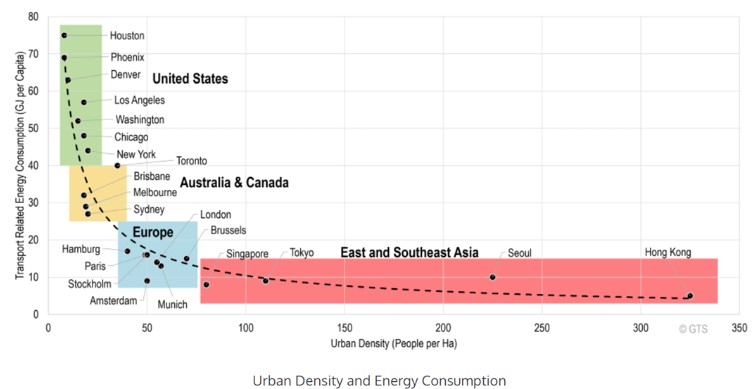
But this thinking can become problematic when it is assumed these overseas cities achieved their higher densities by stopping outward expansion to force the city to grow up – which is not what happened. Yet there are a group of New Zealand planners and people in the wider public who believe this approach is self-evident, common sense even. They believe that allowing any outward expansion will reduce density. Implicitly they believe that cities respond best to the ‘stick’. For example the Greater Christchurch spatial plan in its latest draft makes the argument for urban growth boundaries to prevent outward expansion and has followed through with this thinking by not designating any public right-of-way corridors outside of the existing urban footprint.
Building out from a city can be desirable because of lower land costs. The New Zealand Infrastructure Commission found between 2010 and 2021, nearly every large New Zealand city experienced significant increases in the value of urban land relative to nearby rural land. For instance, in 2010, Auckland’s urban land values were 2.1 times higher than the value of adjacent rural land. By 2021, this ratio had risen to 4.4.
Land prices in inner areas are less likely to escalate rapidly when potential new developments at the fringes provide options, including well-designed greenfield transit-oriented development. Without such options, it is too easy for any improvements in a city’s desirability, or for productivity increases in the urban area, to simply lead to land price increases that benefit existing landowners rather than residents and potential residents more broadly (A New Approach to Urban Planning, 2021, P.9)
Successful high density overseas cities were not the product of a ‘stick’ approach, that could unnecessarily escalate urban land prices which would degrade the attractiveness of the city, resulting in less higher density houses being built within the city’s urban footprint. Case study analysis in the paper A New Approach to Urban Planning indicates great cities have well established planning policies that enable both up and out urban development.

Source – A New Approach to Urban Planning - Table 1: Case study cities’ performance on key metrics
A well-designed transit-oriented development outside a city’s urban footprint will have better energy use credentials compared to poorly designed infill housing within a city. For example, this rail suburb built outside of Tokyo using land readjustment infrastructure funding financing will be more energy efficient compared to an infill development in a typical New Zealand city suburb.
It is notable that a 10% increase in citywide average population density only leads to a roughly 0.6% reduction in vehicle travel (A New Approach to Urban Planning, 2021, P.12). As shown in the above table, cities that have adopted a regional spatial planning type approach have achieved significantly larger emission reductions. Successful cities use a ‘carrot’ approach of working with not against network effects. In particular they price newcomers in not out.
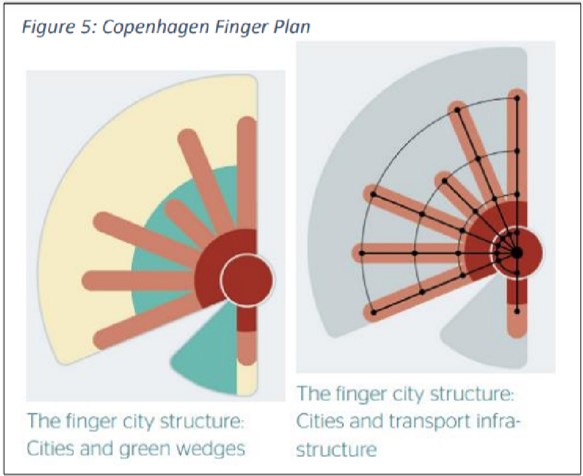
Source – A New Approach to Urban Planning - Case study 3: Copenhagen (Denmark)
Copenhagen is a good example of working with the network effect. Planners back in 1947 understood growth would occur on expansive transport corridor fingers (initially five lines for passenger trains with a total of 170km of track) but where these lines connected in the palm of the hand there would be a concentrated network effect which would drive even greater density growth.
At the long-term regional spatial plan level, it is important to keep an open mind, to be expansive to the possibilities of how cities will move forward. For instance, it is not necessary to choose the fingers or the palm – both should be enabled. The resulting regional plan should reflect this open-minded thinking. Long-term this will give the most choices and the best outcomes. When specific projects are being decided upon is the time to weigh up the individual costs, and other important outcomes, such as CO2 emissions and so on.
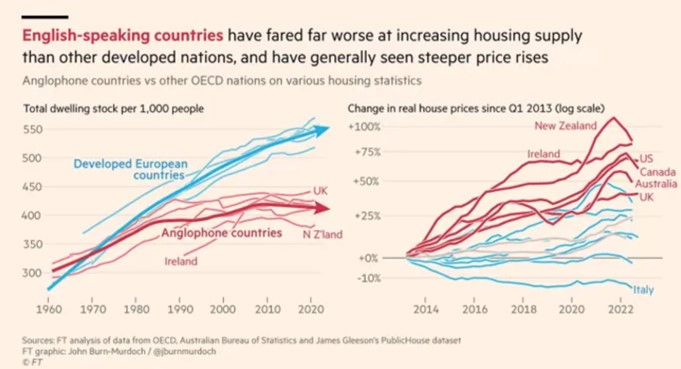
Source - The Anglosphere needs to learn to love apartment living by John Burn-Murdoch
Unfortunately, the Anglosphere countries have not built at the same rate as other countries, in particular because they have under-supplied higher density apartment living options. See the podcast titled - Apartment Living Cures Housing Viruses - for the full explanation, but the short version is the sort of positive network effect that the likes of Copenhagen and Tokyo experience has been inhibited in Anglosphere countries.
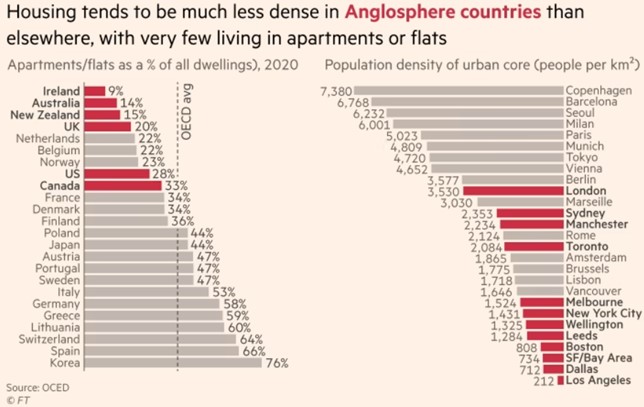
Source - The Anglosphere needs to learn to love apartment living by John Burn-Murdoch
There seems to be some sort of cultural backlash against apartments – perhaps too much scarring from a failed attempt at densification post-WW2 with high-rise social housing towers. Although it could be a historic attitude “that values the privacy of one’s own home — most easily achieved in low-rise, single-family housing. The phrase ‘an Englishman’s home is his castle’ dates back several centuries” (The Anglosphere needs to learn to love apartment living).
Maybe New Zealand needs more people who have experienced attractive mid-rise apartment living overseas to clarify it has many advantages and is not the dystopian nightmare that some fear.
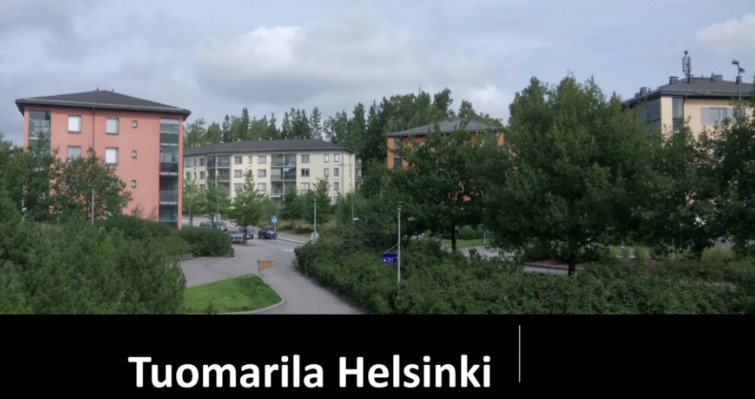
The view from my apartment 2005 to 2012. All of the mid-rise apartment buildings in this view were built during the time I lived in Tuomarila. It was one of the best places I have lived.
The cultural backlash against higher density housing which New Zealand is experiencing threatens to inhibit the ability for cities to build up which directly clashes with New Zealand planners, such as Timothy Welch insisting that cities cannot plan to build out, that urban growth boundaries must be imposed. Future generations, ‘generation rent’ as some have labelled young New Zealanders who seek their right to the city, are likely to be collateral damage in this clash. Surely there is a better way forward — overseas cities have become great — what have they done?
What lessons do great cities provide?
Clearly long-term planning that ensures a plentiful supply of both developable private land and public land for lower cost infrastructure corridors is important. Excessive demand and insufficient supply for city real estate - both private land and public street spaces - leads to congestion and escalating land prices which inhibits the inclusivity of city networks. This process does though hint at infrastructure funding tools that could help cities pay for the infrastructure needed to increase developmental capacity and enable city networks to be more inclusive.
The English-speaking world needs to get over its irrational fear of apartments – especially the attractive human scale mid-level buildings that are commonly found in Europe and Asia. Providing greater choice in housing typologies is a good thing because it meets the needs of a greater variety of people – it is including not excluding.
Overall, it is most important that city networks are inclusive – great networks are how cities become great. Cities should ensure there is affordable access to as many beneficial network opportunities as possible. This will cater for the greatest number of people in a way that best suits their differing life situations and preferences.
Finally, city-based networks respond best to a light touch, more not less choice, a ‘carrot’ not the ‘stick’ approach that works with not against positive network effects.
. . . . .
*Often my articles are republished on the interest.co.nz website which allows comments from the wider public. One commentator who uses the moniker – Powerdownkiwi (PDK) argues that long--term growth is not possible and shouldn’t be planned for because of its exponential nature leads to over exploitation of resources which inevitably causes a Malthusian population collapse (PDK is particularly worried that fossil fuel use is a society supporting energy bonus that cannot be replaced).
I would like to pre-emptively counter PDK that technology has allowed humanity to experience a sigmoidal growth curve to a higher stabilised population level and I am reasonably confident that ‘necessity being the driver of innovation’ will allow humanity to maintain this stabilised level – see the video Beyond Malthus and Boserup for the full explanation.
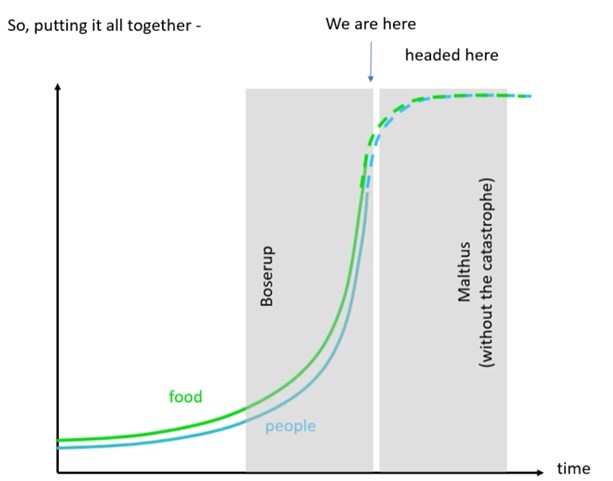
Further, New Zealand cities in the future might not grow because of economic growth but because of the global movement of peoples in response to climate change. For example, later on in the century Southland might have a very desirable climate in a much warmer world and it is possible Invercargill could have a golden-age. It is hard to know if this is likely, but it is certainly not inconceivable. Having city plans that can cope with different growth scenarios – such as Auckland’s population doubling by 2073 - is a contingency that policy makers should take seriously.
This is a repost of an article here. It is here with permission.
57 Comments
I had a quick skim of that paper ‘A New approach to urban planning’. I don’t have the time or interest to address all of its strengths and weaknesses, but to note for a starter it makes some very distorted observations about the planning system in Japan. The system there is nowhere near as flexible as the paper suggests.
The system there is nowhere near as flexible as the paper suggests.
Evidence? Planning in Japan is very efficient and flexible based on my experience.
Evidence:
Start with Sorensen’s authoritative text ‘The Making of Urban Japan: Cities and Planning from Edo to the Twenty-First Century.’
Also I think I know a thing or two, having a PhD in urban geography which at least partly looked at Japan. As you know I also lived there for several years and am fluent in Japanese. I have read a fair bit in this space.
Also I didn’t say the Japanese system is without merit. I just said the authors of that paper exaggerate it’s flexibility. Certainly I love how the Japanese system provides the flexibility to establish a small florist or barbers in residential areas. NZ could learn a thing or two from that.
However it’s not all that flexible in terms of developments that push the zoning boundaries. Larger scale developments have to attain a certain % of support from residents in a community, as you can imagine this is often not easy to achieve. Although developers often get around it via $$$ or other nefarious means.
Sorry but I don't understand what you're talking about. Can you give any specific examples? Tokyo itself is not the most well-planned city in a Western sense, but the integration of public transport within the greater city is second to none. If you're talking about planning from a Western POV, cities like Sapporo are superb with its grid-like layout and integration with public amenities like parks. The corridor between Osaka and Kobe is wonderfully planned.
You are talking about infrastructure planning. It’s superb.
My point was about land use planning and consenting processes. And that’s what I am referring to in that paper. They have a standardised zoning system. That is good in some ways in terms of consistency and efficiency but also has less of a discretionary aspect to it, which can result in less flexibility. And that situation I describe of developers having to get a certain % of local resident support for larger scale proposals.
By the way, there are plenty of examples of shambolic planning in Japan, at the edges of some urban areas. Piecemeal and terrible infrastructure coordination.
Get that book if you don’t believe me. It’s a great overview of the good, the bad and the ugly of Japanese urban planning from a long time professor of urban planning in Tokyo.
Sorensen, describing local infrastructure shortfalls (while grand projects advanced):
’It is also significant that while spending on public works increased dramatically during the 1980s, the serious infrastructure deficits of Japanese cities remained. This was partly because new areas of unserviced sprawl continued to be developed…. Perhaps more important, however, is the fact that most of the new money was spent on large-scale construction projects such as the bridges to Shikoku and the Tokyo Bay tunnel’ (page 277)
And this is a good paper which covers the sometimes torturous process for developers of mid to high rise developments which often require public consultation and residents approvals. Not saying this is a bad thing, at all, but it somewhat counters the ultra development-friendly and flexible planning system stereotype. I guess the key thing is the responsiveness of the Japanese planning system for small scale and low impact interventions compliant with zoning codes. But not necessarily so flexible or enabling for development that pushes the boundaries a bit in terms of rules.
https://escholarship.org/content/qt0kk0q51v/qt0kk0q51v.pdf?t=n4ox4m
Perhaps more important, however, is the fact that most of the new money was spent on large-scale construction projects such as the bridges to Shikoku and the Tokyo Bay tunnel’ (page 277)
The Awaji bridge to Shikoku (longest suspension bridge in the world) was a post-bubble spend to keep the economy chugging along. Nothing to do with urban planning.
You want arguments for the of sake of arguments? Best you stick to your knitting, you’re a bit weird in the way you seem to be threatened by my Japan knowledge, like you can’t handle not being the one with the exclusive Japan knowledge. It really is bizarre.
Infrastructure is everything to do with urban planning, the two go hand in hand. The bridge was one example of massive projects drawing funding away from local infrastructure and urban development.
I know nothing about crypto so I can’t and shouldn’t challenge your knowledge on it. You know nothing about urban planning so best you do the same.
outta here weirdo contrarian
You want arguments for the of sake of arguments?
The bridge is in the middle of nowhere and is hardly used. A massive white elephant. I don't think it's a particularly good representation of Japanese urban planning. It was completed as late as 1998, long after Japan had fully urbanized. Awaji has a population of <50,000 people.
A better example of urban planning in the Japan context is how satellite cities / suburbs were built around the train networks.
Brendan, what’s the value of these corridor designating processes in Auckland when there’s hardly any readily developable land left in the rural hinterland?
One of Twyford’s babies was the Auckland to Hamilton spatial plan, incorporating these ideas. He and his advisors had totally misplaced notions of new large greenfield settlements between Auckland and Hamilton. Yet they came away with a flop of a plan, largely because of the lack of potential development land. People should search it up if they don’t believe me.
Anyone who knew a thing about these things knew that from the outset (in fact I told some of the advisors). Yet they plowed on regardless with a futile folly of a plan at great expense, because of ego and ideology.
Here’s the link to that crap Hamilton to Auckland Corridor Plan. Go to page 10 to see the huge number of physical constraints in the corridor which prohibit any significant new urban areas. If you did the same for the Auckland region a similar kind of picture would emerge:
https://futureproof.org.nz/assets/FutureProof/H2A/Final-H2A-Plan-Novemb…
Sure HouseMouse the horse has kind of bolted for Auckland. Sprawling stand alone houses can be intensified but what is harder to fix are post WW2 cul de sac street systems designed for motor vehicles. Designing public transport corridors with good walkable routes to the neighbouring area is not possible for large swathes of Auckland. But still some of the principles can be learnt - such as when the NW motorway was widened in the 2010s space for a mass transit running down the centre - like Perth does - should have been left. If that had been done then Westgate to Kumeu could have had public right-of-way designations for potential future development. Note Westgate is about the same distance from the city centre as my old place in Tuomarila Helsinki - the train which left every 15minutes that I caught could do that run in under 25 minutes.
The weird thing about Labour wrt cities is they are only interested in Auckland and Wellington - yet both of these cities have geographies that has mostly exhausted the desirable out options and need to build up. Whereas Christchurch and Hamilton are far better positioned for the kind of sensible up and out option The New Approach to Urban Planning paper outlines. But none of that work was done for Christchurch or Hamilton.
The horse certainly has bolted in Auckland! Yet the likes of the NZ Initiative write pieces that suggest it hasn’t. Not that I pay them much attention, a very ideological thinktank.
You are right that there’s more potential for that sort of approach in Hamilton and Christchurch.
Another implication of this approach is that if greenfield and brownfield sites within easy commuting range have been exhausted then the land value capture techniques that work well for those options - like land reallocation and targeted rates will also be off the table. But in that scenerio traffic congestion is likely to biting harder so congestion charging would raise more revenue (even if its target was congestion not revenue gathering) meaning there would still be funding for infrastructure corridor upgrades. Of course, LVT would be a more comprehensive solution infrastructure funding and financing option.
The weird thing about Labour wrt cities is they are only interested in Auckland and Wellington - yet both of these cities have geographies that has mostly exhausted the desirable out options and need to build up
Couldn't agree more. Christchurch rejected a rail network being expanded as one example, this would revolutionise the city and allow a much better lifestyle. Nelson took their railway out in the 1950's which has now resulted in it relying for the most part on private motor vehicles for transport. Sadly with these things the councils need to be thinking more of a 'build it and they will come' mentality, as the general public seem to keep pushing back on all viable transport options on the basis that their rates will increase to have to pay for it, madness.
I am sure housing density alone isn't to blame for Auckland city's measly 8% productivity premium (GDP per employee) over the rest of the country, 3% lower than Upper Hutt city even.
The city mostly hosts backoffice operations for large oligopolies that cater to our domestic markets. High migration into Auckland from overseas has arguably worsened economic outcomes for the city.
Advisor be careful of throwing rocks if you are in a glass house. When I looked into the Wellington regional industry stats - 1, professional, scientific and technical services and 2. public administration and safety were the only two to really grow in the last two decades. So it would seem the Hutt Valley's productivity is a function of being close to the capital city rather than any actual commercial ability.
Wellington has a higher proportion of professionals engaged in legal, science, IT and engineering professions as a proportion of its workforce than Auckland does.
Also, South Waikato boasts a higher productivity than Auckland (143k vs 140k).
Hutt Valley's productivity is a function of being close to the capital city rather than any actual commercial ability
Definitely, as they have the flat land needed for industrial space that Central Wellington simply can't offer.
The Auckland waterfront , and Central auckland is probably the best place to start building more aprtments. Within Walking distance of Britomart would be a nice palce to live.
There's probably not much need for extra office and retail space in Auckland Central, so why not build apartments.?
There's probably not much need for extra office and retail space in Auckland Central, so why not build apartments.?
Been having same thoughts. As well as conversion of commercial to residential. Maybe we need a depression for that to happen.
We need councillors of a different generation with more forward thinking, that push back on the public view of doing anything to preserve the way things are now. Naturally the population growth demands from necessity that we build up. People will lose sun at their homes, neighbourhoods will change, house prices will drop or stabilise with the availability of homes and apartments around, but the cities will flourish. People are averse to change, until they get used to it then they wish it had happened sooner.
Featherston is probably an example of an area that has room to grow , and a railway line with a natural advantage over road. At the moment any development would be sprawling single storey houses with 3 garages spaces. But why not build Apartments there?
Of course , you would need to electrify and upgrade the rail service , which need to be done anyway .
Possibly - some land could be reserved south of Featherston along the railway corridor. It is 20km to Upper Hutt so it is not exactly close to urban centres. So to go from a possible future development area to a viable developable area not only would the line need to be electrified but much faster trains would be required.
Its 90 k.m from Central Wellington. A journey otime of just under an hour would be possible . Maymorn would be better , but the area around the station appears to be gated communities.
Ashburton to Christchurch is 90km...
Yes , but no compact central CBD in CHCH like Wellington . And already sprawling in Ashburton.
Featherston has land avaliable by the station , yet walkable form the town Centre.
There could be a station and empty land in Ashburton-North or Hornby-West or pretty much any point in between. And if the Christchurch regional area had fingers of transport corridors that connected in the palm of Christchurch wouldn't that lead to density growth like other great cities have experienced?
Yes , its what Christchurch and surrounding area needs.Probably needs radial lines as well.
Possibly. Not much flood prone land. How about highly productive soils? I think it’s LUC 2 and 3 around there?
I found the best way to fix all the problems in Auckland was to move completely out of Auckland. Basically it's buggered and the only reason to live there is your job.
Out of interest, where do you live?
PDK is particularly worried that fossil fuel use is a society supporting energy bonus that cannot be replaced
Interesting article Brendon thanks. I'm curious to know how you think we might be able to replace FF for fertilisers and transportation though...
Some new low energy atmospheric nitrogen fixation method maybe?
I think EVs at the light vehicle level will become mainstream fairly soon which will help solve half the transport problem. Heavy vehicles, ships and long haul flights I am not sure about and I am not an agricultural expert so my opinion on how to replace FF for fertiliser is pretty worthless.
This looked good to me - but what do I know...
https://www.youtube.com/watch?v=aT2ji_tdHG0
Interesting video. I'm sceptical about using biochar though due to the energy required to produce it.
Of course we actually have all the nutrients we need in our soils already (most of them unavailable to plants in minerals and humus though) it's just that we strip them off faster than they can be replenished from those non labile parts. Now if we could speed that process up a bit... no more need for superphos from Western Sahara.
Re light EVs...the only problem is what is used to make the electricty. In NZ it makes sense but in coal burning China and India, not so much.
I had a go at making biochar, not only do you need a large amount of wood ( given my first time probably allowance needs to be made for bad technique), but a large amount of water to put it out.
My mate said why not just bury the wood , so i'll try that instead. a lot slower , though the use of treated lime may speed it up .
I was wondering if adding biochar to the compost from this barn system would create the black earth effect?
https://www.rnz.co.nz/national/programmes/countrylife/audio/2018892833/…
Also in theory farmers should be paid for using biochar because they are sequestering carbon.
NZ is a basket case.
Follow the money:
a) greenfields subdivision is heavilty subsidied by existing ratepayers rather than new homeowners paying the full cost via targeted rates.
b) road users get a raft of massive subsidies and dont pay anywhere near the full cost of travel.
c) RMA rules stacked as high as the skytower written by planners imposed rules, especially low density zoning rules, that weren't required to go through individual cost benefit analysis further increased the subsidies through forced regulation. (The government's more recent changes go someway to address these but nowhere far enough. The SPA & NBEA are pretty much just RMAv2 if the financing doesnt also move)
d) Public transport is just that Public Transport in the first instance. Its meant there for those without alternative transport for those without cars, but nowhere do we see full coverage networks at decent frequencies actually providing this alternative transport (on-demand services make this viable).
Providing alternative transport for those with no other means is a crown social outcome (not a local government outcome) and should be funded by the crown, but this is not the case for 99% of PT. Only the biggest new schemes capital cost gets crown funding.
Well put.
A change that could make a huge difference is taking away the discretionary process for all multi-unit developments. Simply apply performance standards. If a developer’s proposed apartment development complies with the performance standards then no resource consent required. Any non-compliances have only those non compliances addressed.
People go on and on about zoning but tend to ignore these other aspects. A zone may enable 6 storey development, but if a discretionary process is required for every development, with urban designers at councils bringing all sorts of subjective assessments to the table, then you aren’t going to see enough apartment development happening.
Even good apartment proposals often take 5-6 months to get resource consent approval in Auckland. Even on good proposals there will always be several issues raised. These timeframes and all the associated costs are just not good enough to get housing delivered en masse.
What’s the saying, perfection is the enemy if the good?
Good, but not over the top performance standards can ensure a minimum quality of outcome. That’s enough.
Interesting to see Leith ‘The Unconventional Economist’ over at Macrobusiness convert from a supply-side believer to a supply-side skeptic over recent years:
https://www.macrobusiness.com.au/2023/06/developer-land-banking-drives-…
The article does no such thing, in fact it points out the restriction of supply by the developers as being one of the reasons for lack of supply inspite of the supposed plentiful supply.
Dp
Tim Walsh is wrong and just sees any sprawl as taking away the opportunity to force people into density.
As you say carrot is better than stick especially when carrot results in more affordable housing.
I had friends living in a semi circular apartment community in Malaysia, it was fantastic. 20 stories high, long wide apartments with plenty of space, in the centre at ground level was a large pool for residents, barbecue areas and a large parklike grounds with playgrounds and tennis courts. Was fenced, safe for children, had underground parking. Probably took up around 150x300m, probably housed around 1000-1500 people. All the services a community needs, minus the shops. https://goo.gl/maps/uQXMSA1boM6dTMqM8
I don't know why we don't embrace more condo style living here like that, imagine that in a place like Auckland. Looking at an inner city suburb there about the same size and you have about 120 houses, housing, if you are lucky 500 people. Oh and that Auckland area doesn't have anything like services in the Malaysian example.
Great comment Blobbles. I would be interested in any other comments about living in apartments. My apartment complex in Finland was smaller - only 45 units in 2 buildings but we had a play ground which we used a lot because we had young kids at the time.
Not as modern of an example but I lived in Edinburgh in tenement flats for a couple of years. Four-story high buildings built around a city block with 4 1 bedroom flats on each level. Each had a spacious living room, smaller kitchen, smaller bathroom and shower and spacious bedroom. Great in the winter as you would get the heat from the surrounding flats, there were licenses issued by the council for any property with more than 2 occupants for fire safety reasons (requiring seals around the edges of all doors etc). Granted they wouldn't be for families, but for young professionals it was perfect. Supermarket nearby and bus stop 30m from the door, with a fantastic bus service, also 20min walk to the centre of the city.
https://www.google.com/maps/place/17+Yeaman+Pl,+Edinburgh+EH11+1BS,+UK/…
I think the problem with these sort of apartment communities, and condo living in general, is that you tend to start seeing lots of dogs wearing nappies.
Why is this hard?
Zone for high density near train stations, med density near bus routes. No objections. No hand wringing either when some people get lucky. It's life.
Brendon makes a false assumption - prima facie.
He assumes technology (a) was a driver, and (b) can conjure up energy.
It is sad to see such misunderstanding, this late in the human-overshoot trajectory. Energy-use can be made more efficient via technology (New Castle to Mallard) but cannot overcome the Laws of Physics, nor conjure energy out of a hat. No city made it to over 1 million, ex fossil energy; never forget that. The decay is setting in now - inability to 'fund' infrastructure, lack of resilience, health in tatters, tertiary education in a (and I quote) downward spiral. We have to pin the tail low enough on the donkey, that we can maintain the level at which we put the pin.
Homework for the writer: https://open.umn.edu/opentextbooks/textbooks/980
I did not think I would shift your Malthusian doomerism PDK but it was worth a shot ; ) Stay well
Interesting that you need to deride-label, then add an emotion.
Wouldn't need to if you had facts.
It might be nice if good design got a look in: successful denser cites have well designed dwellings that meet people's needs, including comfort and privacy.
Unfortunately, the way our design rules are written means we are having large numbers of small apartments being built to minimum possible standards of noise control, comfort, accessibility... and New Zealanders have not learned to live in close proximity to others: there's always some muppet with a big stereo, or parties like it's 1999.
There will be good medium density developments, but a lot of them look like slums of the future, now.
New Zealanders - like everyone else - have not learned to curtail population/consumption.
Given the ramifications, loud music is small beer.
I found myself profoundly irritated by Brendon's article. Perhaps because of the utopian tinge, perhaps by the way he airily moves populations here & there (by carrot or stick), or perhaps just because I am a grumpy old man.
I imagined his beautiful prose is quite similar to that used by the Roman intelligentsia as the barbarians camped outside the gates.
Yes we have become used to our "betters" (elected or bureaucrats) using our tax contributions to promote their favourite schemes of the moment. That they are sincere in their plans doesn't entirely excuse their casual arrogance.
But I rather imagine there are far more powerful influences at play, which will influence the size and shape of our towns & cities, than just good, well intentioned town planning principles.
For example, as we speak the great cities of Europe are experiencing profound change as a result of the fact that the world is on the move. Thousands, even millions are crossing borders, legally or illegally in search of that better life. And the indigenous populations are bordering on irreversible decline.
We are slightly different in NZ but our economic decline seems hardly to be considered in this discussion on urban form. Auckland (apart from geographic limitations to growth, as mentioned by others) has moved from being our premier export port to a situation where many see the growth of "nice" apartments being more important than having any sort of port! This might seem quite academic except our national economy, despite efforts to diversify, remains largely dependent on trade, and in particular agricultural trade, which must, repeat must, at least balance our high reliance on imports if our long term future is to be viable.
But aside from these inconvenient truths, and the end of growth theory advanced by PDK, I find some of assertions against rural communities just plain wrong.
But, yes, I am a grump, and yes, it may be nice for a knowledgeable chap like Brendon to write about "sound" town planning principles. It might be nicer however, to at least acknowledge that there other, possibly more important principles, at play. Our quite recent fascination with junk as evidence of our material wealth and societal success might be another factor in play as we design our living spaces, too.
I am sorry I irritated you Mills. It is my point of view that I thought worth sharing...

We welcome your comments below. If you are not already registered, please register to comment
Remember we welcome robust, respectful and insightful debate. We don't welcome abusive or defamatory comments and will de-register those repeatedly making such comments. Our current comment policy is here.